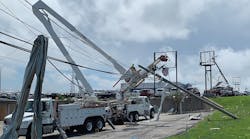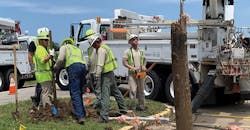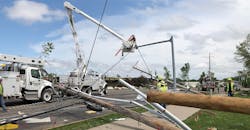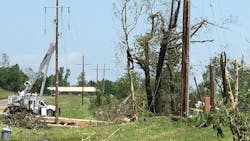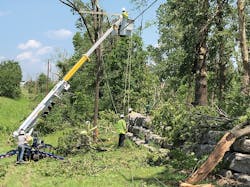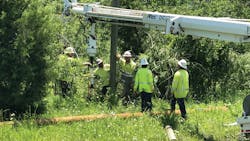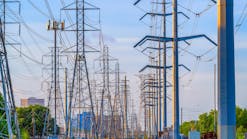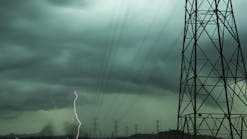Tornadoes in May are certainly nothing new to Kansas, Oklahoma, Missouri, or the U.S. Midwest in general. What is relatively new is the number and frequency of the tornadoes that tore through the middle of the country in May 2019.
The numbers are still being calculated by the National Weather Service and other government agencies, but early reports (June 2019) show upward of 500 reported tornado sightings across the middle of the country. That is roughly twice the traditional number of reported May tornadoes of between 200 and 300, and again, statistics are still being collected.
Included in May’s tornado streak were at least 50 significant events, that is, those of a categorization EF2 or higher. Eighteen were EF3 tornadoes, spanning Nebraska, Kansas, Texas, Missouri, Oklahoma, Indiana, Iowa, and Ohio, with additional tornadoes confirmed from California to New Jersey. Four tornadoes during were fatal, causing a total of eight fatalities.
By the time May 2019 drew to a close, tornadoes were confirmed in 23 different states, and on May 29, the country experienced its 13th straight day with at least eight tornadoes, which broke the previous record of 11 days straight set in 1980. For that stretch of time, the United States had an average of 27.5 tornadoes per day.
What this whopper of a tornado season also meant was that electric utilities were kept quite busy restoring power to a large swath of the country.
“In May of this year alone, we had 85 confirmed tornadoes in the state of Oklahoma,” said Sid Sperry, director of public relations, communications and research with the Oklahoma Association of Electric Cooperatives. “That, plus the torrential rainfall that has followed, has certainly caused a lot of problems.”
Downed poles and widespread power outages are the “triage” elements of tornado restoration, Sperry said, noting that Oklahoma’s electric cooperatives have twice the miles of power line strung throughout Oklahoma than all of the state’s investor-owned and municipal utilities combined.
Two things help keep such a massive electric wires network running, he said. “We are an ‘active weather’ state,” he began, “from tornadoes in the spring to thunder and lightning in the summer to ice storms in the winter, we are very experienced at restoring power.”
The second key, Sperry added, is mutual aid. Each REC in Oklahoma participates in a statewide mutual assistance organization. Since this spring’s tornado path swung primarily through the northeastern corner of the state, cooperatives from central and western Oklahoma were key elements to recovery.
“During the last 45 days we have had six crews from central and western Oklahoma that have gone to northeastern Oklahoma to help them,” Sperry noted. “I liken it to a rock being thrown into a pond. Once word goes out that someone needs help, it ripples out to the statewide safety and loss control program, and we coordinate the sending of crews and the amount of equipment needed based on the crew that is needing aid. We are very blessed to have every coop in our state participating in our program.”
When crews arrive on scene, the first order of business is to survey the damage and radio in what is needed. Restoration is traditionally started at the substation level and goes out to individual homes and businesses. “Once the three phase lines are isolated, we go after all the single-phase lines, right up to the last house on the line,” he said. “But there is a very deliberate process that every co-op goes through. Safety is our greatest concern, and so we have to individually inspect every house before we can turn a circuit back on.”
Snapped Poles and Extraordinary Effort
Mike Hyland is vice president for engineering for the American Public Power Association (APPA), representing municipalities and public power companies across the country. “This past May seemed as active for tornadoes as we have seen in at least a decade,” Hyland reported.
Hyland noted that for the most part, public power companies were able to handle this spring’s tornado rampage on their own, without calling on APPA national mutual-assistance partners.
“The exception was in Ohio, where one of our members — near Selina — got crushed,” Hyland said. “We sent several people there. But in other areas, we were relatively lucky and they [the tornadoes] missed most of our members. For public power, we are sort of like little dots of light. It can be hit or miss.”
That said, over the years Hyland said he has seen what tornadoes can do to overhead electric power distribution networks.
“They just snap poles in half and they are gone,” he said. “You are finding transformers and relays hundreds of feet, very far away. It is typically a complete rebuild, but often for a very specific section of the network.”
One city that needed that complete rebuild for a relatively large section of its distribution network was Jefferson City, Missouri, the state’s capital with a population of about 50,000.
Just before midnight on May 22, an EF-3 tornado with maximum wind speeds of 160 miles per hour ripped a path of destruction through Jefferson City, tearing apart homes, ripping off roofs, severely damaging businesses, office buildings and several historic homes along Capitol Avenue. Nearly two dozen were injured and taken to hospitals for treatment, while a critical section of the city’s distribution network was torn apart.
Chip Webb, director of the Central Missouri Division for Ameren Missouri, said he got a call around 11:30 p.m. on that Wednesday night in May to round up crews.
“This was unlike anything we had ever seen in this town,” Webb said. “I talked to linemen who had come in from other areas, and the initial assessment was this was as bad as many had ever seen.”
What Webb and others saw was a path about four blocks wide but three miles long, he said, with what looked well over 100 poles down.
“We had local crews out immediately, by 12:30 a.m., starting to move around, look for downed wires, see what we had,” Webb recounted. “We got a good indication of feeder outages, and set up a ‘safe zone’ where we could work inside of while still keeping customers’ power on as long as we could.”
That process took about 10 hours, Webb reports, extending into the late morning in order to count all the poles that were down and do surveillance both on foot and using drones overhead to provide photos and video footage.
Since Jefferson City is in central Missouri, two hours west of Ameren Missouri headquarters in St. Louis, calls went out to St. Louis to deploy from there around 4 a.m. to make it to Jefferson City around sunrise. By the end of the day Thursday, Webb said, the company had engaged some 250 line workers in storm repair — including contractors — and most arrived late in the morning on Thursday.
“We were able to get crews up at 4 a.m. and on the road,” Webb said. In addition to the line workers, Webb was also able to call on six “storm trailers” — 53-ft long box trailers pre-loaded with storm recovery materials that were sitting ready in St. Louis. The company also sent two mobile command centers, fully functional stand-alone vehicles that let a team of coordinators plan and execute power restoration. “We got both of those in place by 7 a.m.,” he said.
Webb said it was clear by daylight that they were dealing with “at least a hundred” poles down, as well as some sub-transmission structures that would have to be replaced. Among the latter was a “winding curve” section of the circuit that needed to have six composite poles of 70, 80 or 90 ft replaced. These particular composite poles traditionally take up to three or four months to deliver under normal circumstances. But Ameren was able to locate the pole supplier in Illinois and the company “came through for us,” Webb said, by delivering the six new poles needed before the end of the day Thursday. “That was a fairly important piece of the circuit,” Webb added.
“By noon on Friday we had installed 130 or 140 poles and were starting to string wire,” Webb said. “We were probably about 80% complete with the restoration. When it was all said and done, about mid-afternoon on Saturday, we had replaced 190 poles in 48 hours. We do this a lot and we are pretty good at it, but there were a lot of people pretty amazed of what we were able to accomplish.”
Webb said the key to fast and effective power restoration is to start a bit more slowly — that is, plan ahead and create an ample and safe work zone in which to receive and unload supplies, plan the restoration and dress new replacement poles.
“We spent the first 12 hours assessing and getting a zone of protection in place, and then we could take the gloves off and really go to work,” he observes.
In addition to the use of drones for post-storm surveillance and damage assessment, Webb cited the utility’s three vacuum excavation units as significant restoration-helpers.
“They saved us a lot of time,” Webb recalled. “The laminate poles were set in culverts filled with gravel. We could suck the gravel out using the vacuums, and we also had some underground facilities in the way. We can do a lot with vacuum units.”
“We have been in the drone business for about three years,” Webb continued, “with a team of five to six pilots that go around the state doing drone inspection work, routine system inspections. When a storm hits, we get them out and they are able to do the patrolling and reconnaissance in place of a crew walking down a lead to find out what it going on.”
Webb said drone inspection is much quicker and safer than ambulatory inspection by line crews, while also providing good video for damaged equipment estimates as well as exact GPS coordinates so ground crews can find damaged poles more quickly and accurately.
Technology aside, Webb gave the lion’s share of credit for storm recovery to the hard-working Ameren Missouri staff, both in the field and supporting the line workers sent on storm restoration.
“The extraordinary effort that I saw with our crews was so impressive,” he said. “As a lineman, when you walk up and look at a devastated area like we had, it really hits you. This is also our hometown, my hometown. Guys were engaged, and ready to collaborate with the first responders first thing Thursday morning. It was impressive how quickly and safely we did it.”
Technology, Preparedness and Customer Service
A couple of May’s tornado touchdowns were also in Arkansas, but according to Lewis of Entergy Arkansas, it is the heavy thunderstorms that often either precede or follow tornadoes that really causes damage to lines and distribution networks.
“Flooding was a much bigger deal for us,” Lewis said. “These tornadoes and thunderstorms come and go so quickly. Tornadoes are also more specific in where they land, but you are still dealing with trees onto power lines, broken poles and access problems where trees are falling onto roads.”
Lewis said being in an “active weather” state like Arkansas means has ongoing storm preparatory measures in place.
“We stay in a sort of permanent state of preparedness,” Lewis said. “Our people are always on call, and responding to unforeseen trouble is just part of the job. On the other hand, when you’ve severe weather coming and you know it, there are additional things we will do and the degree to which we do them will change. We might have to cancel vacations, fuel up the trucks, make sure you’ve got plenty of poles in the yard. Many of the people in the office have their normal jobs and then they have their storm duty jobs.”
Technology has changed the way Entergy Arkansas as well as other utilities do storm restoration as well. Lewis said Entergy also uses drones to survey post-storm damage and to perform repair assessments. The utility has also made strategic changes to network architecture and design to facilitate faster, safer storm response.
“Drones have been extremely useful in certain circumstances where you can fly the drone still within line of sight but it can see into places you would have trouble getting to by foot or by vehicle,” he said. “I know that we have placed an emphasis in the past few years in sectionalizing our distribution lines, so that when there is a problem it affects fewer customers. We routinely reroute power around problem areas. Initially we may have 10,000 customers out but using our technology we figure out the options and are able to feed half of them from another direction and quickly get the number down from 10,000 to 3,000.”
Energy Arkansas is present on social media sites like Facebook and Twitter, and during storms, it is a two-way conversation, Lewis said.
“When a storm is coming and we know it, we will post messages to the extent of be storm ready, charge up your communications devices and cell phones, know where your family is, and if you do experience an outage keep things in mind like don’t open your refrigerator or freezer and food will last longer,” Lewis said. “Have flashlights, don’t burn candles or be careful if you do. Check on your neighbors. If you are depending on electricity for medical reasons, you should have a backup plan, because at one point or another everybody loses power. You should have another place to go or battery backup for any medical devices.”
Entergy customers also have the option to sign up for the company’s My Account online service, and those that do receive texts when the power goes out. That might sound counter-intuitive, Lewis said, but in cases where people are away from their homes when the power goes out, they appreciate the alert.
Sperry also touted social media as a relatively new but resourceful and effective tool his Oklahoma co-ops use to communicate during and immediately after powerful storms.
“Our local co-ops do a great job of communicating potential outage times,” Sperry said. “They coordinate that through local communications departments, and social media has become a great player in that.”
